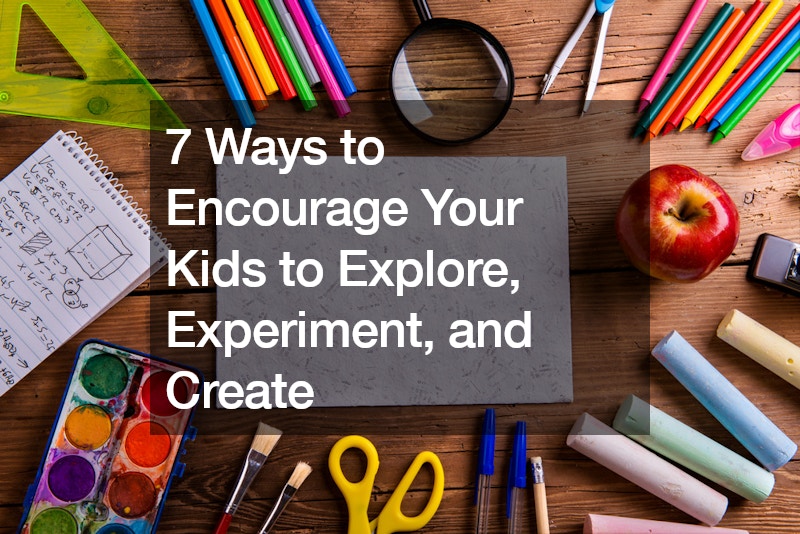
Creativity is the essence of childhood—a boundless reservoir of imagination, curiosity, and innovation waiting to be unleashed. From the moment they come into this world, children possess an innate capacity for creative expression, eagerly exploring the world around them with wide-eyed wonder and uninhibited enthusiasm. As parents and caregivers, it is our privilege and responsibility to cultivate and nurture this precious gift of creativity, guiding our children on a journey of exploration, experimentation, and creation.
In this article, we delve into the importance of creativity in early childhood development and explore ten effective ways parents can inspire their children to explore, experiment, and create with boundless imagination and enthusiasm.
The Importance of Creativity in Early Childhood Development

Creativity plays a fundamental role in the holistic development of children, influencing cognitive, emotional, and social growth during the formative years. Here’s why fostering creativity in early childhood is crucial:
1. Cognitive Development:
Engaging in creative activities encourages children to think critically and find innovative solutions to challenges they encounter. Through experimentation and exploration, they develop problem-solving skills that are essential for academic success and lifelong learning.
Creativity also nurtures flexible thinking, allowing children to approach tasks and problems from multiple perspectives. This adaptability enhances their ability to adapt to new situations, think creatively, and navigate complex challenges in various domains of life.
2. Emotional Expression:
Creativity provides children with a means of self-expression, allowing them to communicate thoughts, feelings, and experiences in non-verbal ways. Art, music, and imaginative play serve as outlets for emotional expression, helping children develop a sense of identity and self-awareness.
Engaging in creative activities can promote emotional regulation by providing a constructive outlet for managing stress, anxiety, and frustration. Creative expression can teach children to cope with their emotions in healthy ways, fostering resilience and emotional well-being.
3. Social Development:
Collaborative creative projects encourage children to work together, share ideas, and communicate effectively with their peers. By collaborating on creative endeavors, children learn valuable teamwork skills, negotiation techniques, and conflict resolution strategies.
Creative activities involving storytelling, role-playing, and artistic expression can enhance children’s empathy and perspective-taking abilities. Through imaginative play and creative storytelling, children learn to understand and empathize with others’ experiences and emotions.
4. Imagination and Innovation:
Creativity fuels curiosity and imagination, inspiring children to explore, experiment, and discover the world around them. Parents and educators can nurture children’s natural curiosity and stimulate their thirst for knowledge if they encourage imaginative play and creative exploration.
Moreover, creativity lays the foundation for innovation by fostering a mindset of curiosity, experimentation, and risk-taking. Children who are encouraged to think creatively are more likely to become innovative thinkers and problem-solvers, driving progress and advancement in various fields.
Practical Strategies for Fostering Creativity
Now that we’ve explored the importance of creativity in early childhood development, it’s time to delve into practical strategies and tips for inspiring your children to explore, experiment, and create.
1. Encourage Open-Ended Play
Encouraging open-ended play is essential for nurturing your child’s imagination and creativity. By providing toys and materials that allow for limitless exploration, you empower your child to unleash their creativity in unique and unexpected ways. Instead of toys with predetermined outcomes, opt for versatile options that inspire open exploration and imaginative thinking.
For example, consider stocking your playroom with building blocks, LEGO sets, or magnetic tiles that can be transformed into endless creations. Dress-up costumes and props encourage role-playing and storytelling, allowing children to inhabit different characters and scenarios. Additionally, simple household items like cardboard boxes, fabric scraps, and kitchen utensils can become the building blocks of imaginative play, fostering resourcefulness and innovation.
2. Incorporate Art, Music, and Movement Into Daily Routines

Incorporating art, music, and movement into your child’s daily routines offers a multitude of benefits beyond mere entertainment. It provides them with consistent opportunities to express themselves creatively, fostering a sense of joy, fulfillment, and self-discovery. By weaving these activities seamlessly into everyday life, you cultivate a culture of creativity that permeates every aspect of your child’s existence.
Dance to the Rhythm:
Encourage your child to dance to the rhythm of their favorite songs, whether it’s a lively pop tune or a soothing melody. Dancing not only promotes physical health and coordination but also serves as a powerful form of self-expression. Create designated dance breaks throughout the day or turn mundane tasks like tidying up or preparing meals into impromptu dance parties. By infusing movement into daily activities, you instill a sense of joy and spontaneity while encouraging your child to explore the limitless possibilities of their body’s movements.
Embrace Artistic Exploration:
Designate specific times for artistic exploration, providing your child with a variety of materials to unleash their creativity. Set up a dedicated art station stocked with paints, markers, crayons, colored pencils, and a variety of paper supplies and canvases. Encourage them to experiment with different techniques, from finger painting and collage to drawing and sculpting. Incorporate themed art projects inspired by nature, holidays, or their favorite stories to spark their imagination and encourage artistic expression.
Jam Sessions and Musical Play:
Create opportunities for musical play by introducing your child to a variety of instruments and musical styles. Encourage them to explore the sounds and rhythms of different instruments, from simple percussion instruments like drums and tambourines to more complex ones like guitars and keyboards. Schedule regular jam sessions where you and your child can make music together, improvising melodies, and experimenting with different harmonies. Singing along to favorite songs or composing original tunes fosters a love for music and encourages self-confidence and self-expression.
3. Create a Home Environment Conducive to Children’s Creative Development

Establishing designated areas within your home specifically for creative activities can significantly enhance your child’s creative development and encourage them to turn off digitally. Consider setting up a dedicated art corner, complete with a sturdy table, ample storage for supplies, and a display area to proudly exhibit their masterpieces. Ensure the space is well-lit with natural light or bright lamps to create an inviting atmosphere that encourages creativity to flourish. Encourage your child to turn off digitally while engaging in these creative spaces, promoting a focus on hands-on activities and imaginative play without the distractions of screens.
To further enrich the environment, incorporate additional elements that inspire imagination and exploration. Hang a chalkboard or whiteboard on the wall for spontaneous doodling or brainstorming sessions. Include shelves stocked with a variety of art materials, such as paints, brushes, paper supplies, and crafting tools, to facilitate experimentation and creative expression.
In addition to the art corner, designate other areas of the home for different types of creative activities. Set up a cozy reading nook with comfortable seating, plush pillows, and a selection of books to stimulate imagination and literacy skills. Transform a corner of the living room into a makeshift stage or performance area where children can engage in dramatic play or put on impromptu shows.
Furthermore, involve your child in the design and organization of these creative spaces, allowing them to take ownership of their environment and personalize it according to their preferences and interests. Encourage them to contribute ideas for decor and layout, fostering a sense of pride and ownership in their creative sanctuary.
Beyond the physical environment, consider enlisting the expertise of professionals to enhance your home’s creative potential. Collaborate with a cabinet maker to design custom storage solutions that optimize space and functionality in your art corner. Likewise, ensure the comfort of your home by maintaining reliable heating and cooling services, creating an ideal atmosphere for creativity to thrive in all seasons.
4. Design an Outdoor Playground
Outdoor play is essential for children’s development, offering a vast canvas for exploration, experimentation, and creativity. Transforming a section of your backyard or collaborating on an outdoor renovation project with your local park can provide endless opportunities for your children to unleash their imagination and connect with nature.
Consider installing artificial playground turf in your backyard, providing a safe and versatile surface for creative play. This durable material mimics the look and feel of natural grass while offering added durability and low maintenance. With artificial playground turf, your children can enjoy outdoor activities year-round, from imaginative games to energetic sports.
In addition to the playground turf, incorporate other elements to stimulate your children’s creativity and encourage outdoor exploration. Install a sandbox filled with sand and various toys for sensory play and construction projects. Create a mud kitchen using old pots, pans, and utensils, allowing your children to engage in messy yet imaginative culinary adventures.
To promote physical activity and imaginative play, incorporate structures such as treehouses, climbing walls, or rope courses into your outdoor playground. These features encourage children to challenge themselves physically while fostering teamwork, problem-solving, and creativity.
5. Outdoor Exploration and Nature-Based Creativity
Nature offers boundless opportunities for children to unleash their creativity and engage in sensory exploration. By immersing them in the great outdoors, you not only foster a deep appreciation for the environment but also inspire imaginative play and artistic expression.
Start by planning regular nature walks with your children, exploring nearby parks, trails, or nature reserves. Encourage them to observe and interact with their surroundings, whether it’s examining intricate patterns on tree bark, listening to the sounds of birds chirping, or feeling the texture of moss-covered rocks.
After indulging in these enriching nature walks, consider taking your family on a long weekend nature getaway. Plan a trip to a nearby national park, camping ground, or nature retreat where you can immerse yourselves in the beauty of the natural world. This extended adventure allows for deeper exploration and connection with nature, providing ample opportunities for creative inspiration and outdoor discovery.
Preparing for Your Outdoor Adventure
Before embarking on your nature exploration, it’s essential to make necessary preparations to ensure a smooth and enjoyable experience for the whole family.
Vehicle Maintenance:
Take your car to your trusted auto repair shop for a thorough inspection, including tire pressure, fluid level, and brake checks, to ensure it is in optimal condition for the journey.
Packing Essentials:
Gather all the necessary gear and supplies for your outdoor adventure, including water bottles, snacks, sunscreen, insect repellent, and weather-appropriate clothing. Pack a backpack with items for spontaneous outdoor activities, such as binoculars, magnifying glasses, field guides, and nature journals.
Booking Accommodation:
If your outdoor adventure involves an overnight stay, make arrangements to book accommodations in advance. Whether it’s camping under the stars, renting a cabin in the woods, or staying at a nearby hotel, ensure you have a comfortable and safe place to rest after a day of exploration.
6. Get Creative in the Garden

The garden offers endless opportunities for creative exploration and learning. Involve your children in planting flowers, vegetables, or herbs, allowing them to witness the process of growth and transformation firsthand. Gardening not only nurtures creativity but also instills a sense of responsibility and appreciation for nature.
Gardening Activities:
- Design Their Own Garden Plots: Encourage children to design their own garden plots. Let them choose what to plant, plan the layout, and decide where to place mulch, fostering a sense of ownership and creativity.
- Decorate Plant Pots: Provide plain pots and various decorating supplies like paints, stickers, and markers. Children can personalize their pots, turning each one into a unique piece of art.
- Create Garden Sculptures: Use found objects and mulch to create garden sculptures. This can include making fairy houses, painted rock animals, or twig structures, adding whimsical touches to your garden.
Alternatively, take a trip to a local garden center where children can explore a variety of plants, gardening tools, and bags of mulch for sale. This is a great opportunity to let them pick out seeds or plants they’re interested in, giving them the freedom to make choices and learn about different species. Garden centers often have knowledgeable staff who can provide tips and ideas for kid-friendly gardening projects, including using mulch to suppress weeds and retain moisture in their very own plots!
7. Encourage Collaboration
Collaborative projects provide valuable opportunities for children to learn from one another, share ideas, and work towards a common goal. Early childhood education centers often emphasize these activities, recognizing their importance in early development. These activities not only stimulate creativity but also teach important social skills and foster a sense of community.
Group Activities:
- Building Forts: Encourage children to work together to build forts using household items like blankets, pillows, and chairs. This activity promotes teamwork and problem-solving as they design and construct their shared space.
- Creating Murals: Set up a large canvas or a section of a wall where children can collectively paint a mural. Each child can contribute their unique ideas and artistic skills, resulting in a vibrant piece of collaborative art.
- Putting on Plays: Help children write, rehearse, and perform their own plays. This activity allows them to express their creativity through storytelling, acting, and stage design while learning to collaborate and support each other.
- Group Storytelling: Engage children in group storytelling sessions where each child contributes a part of the story. This activity not only sparks imagination but also enhances listening and communication skills as they build on each other’s ideas.
In a Nutshell
Fostering creativity in children is essential for their holistic development and future success. By incorporating these ten strategies into daily life, parents can inspire their kids to explore, experiment, and create with boundless imagination and enthusiasm. Encouraging creativity not only nurtures individual talents but also cultivates a lifelong love for learning and innovation.


